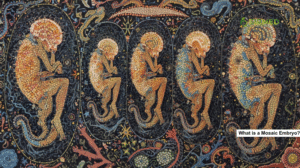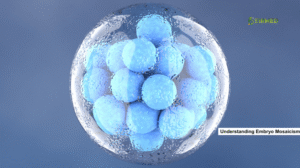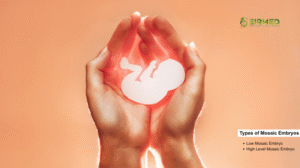Mosaicism Embryo | Proven Facts and Hope in 2025

12 Simple Facts About Mosaic Embryos for Your IVF Journey
 A Mosaicism Embryo is something you might hear about during IVF, and it can sound confusing at first. Don’t worry, we’re here to explain it clearly. At EIRMED, we want to help you understand your fertility options and feel hopeful. We also offer products like vitamins for women’s egg health or supplements for men’s sperm quality to support you. This guide breaks down everything about mosaic embryos in simple words, so you can talk to your doctor with confidence.
A Mosaicism Embryo is something you might hear about during IVF, and it can sound confusing at first. Don’t worry, we’re here to explain it clearly. At EIRMED, we want to help you understand your fertility options and feel hopeful. We also offer products like vitamins for women’s egg health or supplements for men’s sperm quality to support you. This guide breaks down everything about mosaic embryos in simple words, so you can talk to your doctor with confidence.
What is a Mosaic Embryo?
 So, what is a mosaic embryo? It’s an embryo with some normal cells and some cells that have the wrong number of chromosomes. Think of it like a puzzle where most pieces fit, but a few are different. Doctors find this during IVF with a test called PGT-A, where they check a tiny piece of the embryo on day 5 or 6.
So, what is a mosaic embryo? It’s an embryo with some normal cells and some cells that have the wrong number of chromosomes. Think of it like a puzzle where most pieces fit, but a few are different. Doctors find this during IVF with a test called PGT-A, where they check a tiny piece of the embryo on day 5 or 6.
This test looks at the outer part of the embryo, which becomes the placenta, not the baby itself. About 15 to 30 percent of embryos tested show this mix, so it’s pretty common. It’s not your fault—it just happens as cells grow. Knowing this helps you understand your IVF results better. EIRMED has supplements to boost your egg or sperm health, which can make a difference.
Understanding Embryo Mosaicism
 Embryo mosaicism means an embryo has two types of cells: some with the right number of chromosomes (46) and some with too many or too few. It’s like having a mix of regular and odd-shaped beads in a necklace. This happens early, when the embryo is just starting to divide after the egg and sperm join.
Embryo mosaicism means an embryo has two types of cells: some with the right number of chromosomes (46) and some with too many or too few. It’s like having a mix of regular and odd-shaped beads in a necklace. This happens early, when the embryo is just starting to divide after the egg and sperm join.
Studies show about 1 in 4 embryos has some mosaicism. It doesn’t always mean the embryo won’t work—many still lead to healthy babies. Doctors check this to decide which embryos are best for transfer. EIRMED’s fertility kits, like hormone helpers, can support your body to create stronger embryos next time.
Why Does Mosaicism in Embryos Happen?
Mosaicism in embryos comes from small mistakes when cells split after fertilization. Imagine cells dividing like splitting a cake, but sometimes a piece gets cut unevenly, so some cells end up with extra or missing chromosomes. This isn’t caused by your age or habits—it’s just how embryos grow sometimes.
Things like the lab environment or how the IVF process is done might play a small role, but it’s mostly random. One study found 31.8 percent of embryos had this mix. You can’t stop it completely, but eating well and using EIRMED’s fertility vitamins can help your eggs and sperm be their best.
What Are Mosaic Embryos?
 Mosaic embryos are embryos with both normal and not-so-normal cells. They’re kind of in the middle—not perfect, but not all wrong either. The term “mosaic” means a mix, like tiles in a colorful pattern. In IVF, doctors spot this when they test embryos to see if they’re good for transfer.
Mosaic embryos are embryos with both normal and not-so-normal cells. They’re kind of in the middle—not perfect, but not all wrong either. The term “mosaic” means a mix, like tiles in a colorful pattern. In IVF, doctors spot this when they test embryos to see if they’re good for transfer.
If 20 to 80 percent of the tested cells are off, it’s called embryo mosaic. Even natural pregnancies have this, but IVF tests catch it. EIRMED’s ovulation trackers can help you plan your cycles better, so you feel more in control.
Not all mosaic embryos are the same. They’re grouped by how many cells are abnormal.
Low Mosaic Embryo
A low mosaic embryo has mostly normal cells—only 20 to 40 percent are different. These embryos are like the strong players on your team. They have a good chance of working, with about 50 percent implanting and less than 10 percent chance of miscarriage. Many turn into healthy babies because the normal cells often take over.
If you have one of these, it’s a great option if no perfect embryos are available. EIRMED’s prenatal vitamins can help your body stay ready after transfer.
High Level Mosaic Embryo
A high level mosaic embryo has more abnormal cells—40 to 80 percent. These are trickier, with only 25 to 30 percent implanting and a higher chance of miscarriage, up to 25 percent. But some still work, especially if the problem isn’t in important chromosomes. They can sometimes fix themselves as they grow.
Talk to your doctor about whether this is worth trying. EIRMED’s male fertility supplements can improve sperm for your next round.
High Mosaic Embryo: What’s the Deal?
A high mosaic embryo has more cells with chromosome issues, so it’s less likely to succeed than a low one. Still, studies show about 29 percent of these transfers lead to healthy babies. The embryo might fix itself by letting normal cells grow stronger. But there’s a small risk the baby could have genetic issues, so extra tests during pregnancy are important.
Your doctor will help you decide if it’s worth a try or if another IVF cycle is better. EIRMED has products to support your health either way.
IVF: How Many Embryos Make It to Day 5?
In IVF, not every fertilized egg grows to day 5, when it’s called a blastocyst. On average, 40 to 50 percent make it, but if you’re under 35, it can be up to 60 percent. Older age or weaker eggs might lower this. The lab’s skill matters too.
Of those that reach day 5, about 15 to 30 percent are mosaic embryos. EIRMED’s hormone support products can help your body produce more strong embryos.
Can Mosaic Embryos Work?
Yes, mosaic embryos can lead to babies! Low mosaic embryos have a 30 to 50 percent chance of a live birth, close to normal embryos. High mosaic embryos have lower odds, but studies show many succeed. One report found 37.5 percent of 88 mosaic transfers worked.
The risk of miscarriage is a bit higher, but most babies born are healthy. EIRMED’s fertility aids keep you strong during this process.
Can Embryo Mosaic Fix Itself?
Sometimes, a mosaic embryo can fix itself. As it grows, the normal cells might take over, pushing out the abnormal ones. This happens during implantation or early pregnancy. Research shows many mosaic embryos become normal fetuses.
Tests like amniocentesis during pregnancy can check this. EIRMED’s stress-relief products can help you stay calm while you wait for answers.
Risks of Using Mosaic Embryos
Using mosaic embryos means a lower chance of success compared to normal ones. High mosaic embryos especially might not implant or could lead to miscarriage. There’s also a tiny chance the baby might have genetic issues, but this is rare.
Talk to a genetic counselor to understand your embryo’s specific risks. EIRMED supports you with tools to stay healthy and hopeful.
Deciding What to Do with Embryo Mosaicism
If you have a mosaic embryo, you’ve got options. Ask your doctor: Is it low or high mosaic? Which chromosomes are off? Low mosaics are often okay to try, but high ones might need more thought. You could do another IVF cycle for better embryos or go ahead with a mosaic transfer and test later in pregnancy.
EIRMED’s fertility kits help you prepare for whatever you choose, keeping your body in top shape.
Real-Person Success Stories
-
Christina (USA) — “Emilia”
-
Christina had several embryos after IVF, some euploid (normal) and one low-level mosaic embryo.
-
She first transferred a euploid embryo, which failed.
-
Later, deciding to use the mosaic embryo, she transferred it. Despite complications during delivery (placental abruption, bleeding), she gave birth to a daughter, Emilia.
-
Christina reflects that “Without transferring my mosaic embryo, I wouldn’t have Emilia.”
-
-
Anonymous “High-level segmental mosaic embryo” story (Remembryo / Uterine Wall of Fame)
-
A woman, age 32, with a history of 6 miscarriages.
-
Eventually conceived from a Day 6, 5AB high-level segmental mosaic embryo.
-
She had a healthy baby from that transfer.
-
-
Anonymous story: 41-year-old, after cervical cancer, using a mosaic embryo
-
A woman ages about 41, previously had cervical cancer (trachelectomy), extensive fertility treatment (multiple IUIs) and losses.
-
She transferred a Day 6, 4AB mosaic embryo (with a segmental deletion).
-
Outcome: she achieved pregnancy full term.
-
-
Pregnancy with twins from mosaic embryos
-
A woman (age ~30) with 8 years of unexplained infertility.
-
Had two mosaic embryos (each with certain chromosomal variants).
-
Transferred; resulted in twins.
-
FAQ
What is a mosaic embryo?
It’s an embryo with some normal cells and some with the wrong number of chromosomes, found in IVF tests.
What are mosaic embryos?
They’re embryos with a mix of normal and abnormal cells, often still able to become healthy babies.
How common is mosaicism in embryos?
About 15 to 30 percent of IVF embryos have some mosaicism.
Why does embryo mosaicism happen?
It’s from random mistakes when cells divide after fertilization.
Can a high mosaic embryo work?
Yes, about 29 percent lead to healthy births, but risks are higher.
Overall Purpose
This guide explains mosaic embryos in a simple way to ease your IVF worries. It covers what they are, why they happen, types like low mosaic embryo and high mosaic embryo, and how many reach day 5. Learn about success, risks, and self-correction to make smart choices. EIRMED’s products support your health for better outcomes. Stay hopeful—many find success with the right steps. (80 words)
Disclaimer
This guide is for information only and not medical advice. Always talk to a fertility specialist about mosaic embryos or IVF decisions. EIRMED products help wellness but don’t guarantee results. Information comes from current studies and may change as new research comes out.
Thank You
Thank you for reading our guide on mosaic embryos. At EIRMED, we’re here to support your fertility journey with clear information and products for men and women. We hope this helps you feel ready to take the next step.

Eirmed is an informational platform dedicated to providing reliable, science-based insights on male and female fertility, reproductive health, and natural conception.

What i do not realize is in fact how you are no longer actually much more wellfavored than you might be right now Youre very intelligent You recognize thus considerably in relation to this topic made me in my view believe it from numerous numerous angles Its like men and women are not fascinated until it is one thing to do with Lady gaga Your own stuffs excellent All the time handle it up
Thank You 🙂